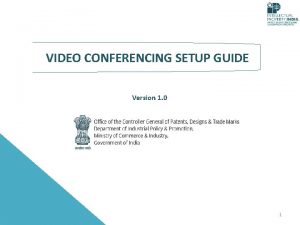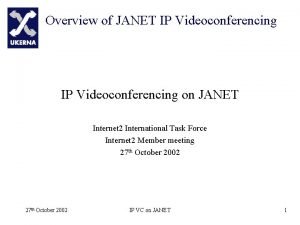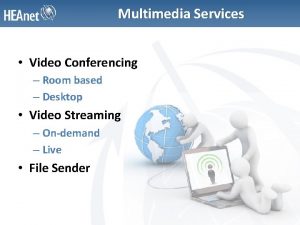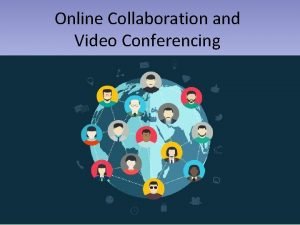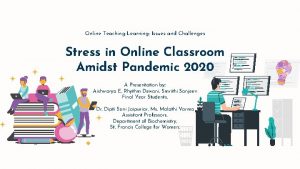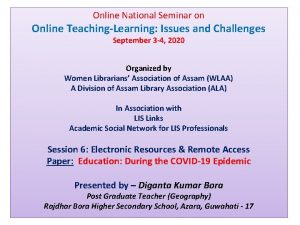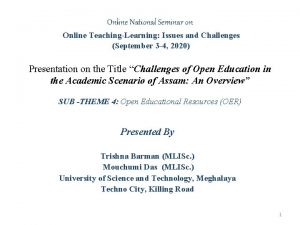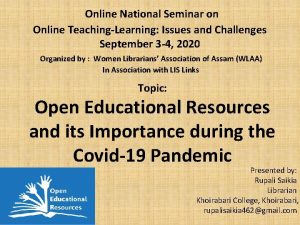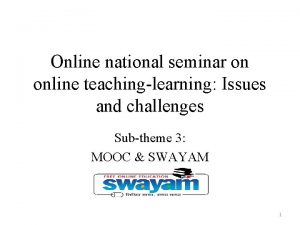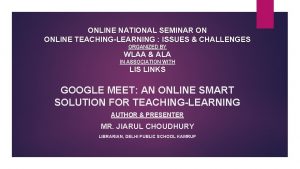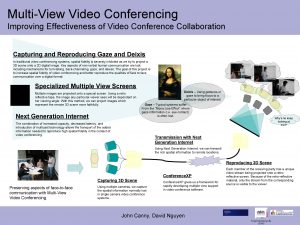Online TeachingLearning and Video Conferencing Its Role during


















- Slides: 18

Online Teaching-Learning and Video Conferencing: Its Role during Impact of the Epidemic on Students By Dr. Nirmal Kumar Khatri Former Associate Scientist Indian Statistical Institute, Delhi Centre Library, New Delhi-110016, India. Mob: 9910613694. Email: khatri 52@hotmail. com and Mrs. Payal Malhotra Librarian, Birla Vidya Niketan, Senior Wing, Pushp Vihar, Sector-4, New Delhi-110017, India. Mob: 9818141168. p 29091981@gmail. com

ABSTRACT • The World Wide Covid-19 Epidemic and School Closures Caused Worry and Uncertainty Among Parents About their Children’s Teaching and Learning. • Classroom Work Has Been Suspended Indefinitely, To Be Replaced By Online Teaching. • This is Particularly The Case For Yearly Years and Nursery. Primary Children For Setting Strong Foundations for Life. • Schools And Educators Must Learn to Adapt and Thrive In An Ever Changing World.

ABSTRACT • The Experienced And Qualified Team Believes That The Learning Must Go On. • And That It Is Possible To Provide Quality, Meaningful and Age Appropriate, Home Learning Opportunities, Even for the Youngest Learners. •

INTRODUCTION • Preparing Oneself With Skill Has Become A Necessity And Online Education Presented The Best Alternative To Traditional Education For Working Adults and People Living In Remote Places. • One Would Need Is Device With Access To The Internet. • Online Education Is Gaining Increasing Popularity Among Students Because of Factors –Convenience, Affordability, Flexibility and Accessibility.

ONLINE TEACHING-LEARNING & ITS BENEFITS • Often Referred to e-Learning. Popular Form of Distance Education. • Several Types : Correspondence Courses, Telecourses, Online Learning, Mobile Learning. Continue to Grow. • Majority of Academic Leaders Believe, Online Learning Quality Is Already Equal To Or Superior to Face To Face Instruction. • Benefit Students, Who Can Not Participate in Traditional Classes. • Excellent Method of Course Delivery, Unbound by Time Or Location. • Ability to Access From Any Computer With Internet Access, 24 Hours, and Seven Days a Week.

ADVANTAGES OF ONLINE TEACHING LEARNING • Convenience: 24/7 Access, Seven days a week. • Enhanced Learning : More Understanding and Discussions. • Interaction : Increase Student-to-Teacher & Student-to-Student. • Innovative Teaching: Students Approaches increase Creativity. Learning • Improved Administration: Ability to record Online interactions. • Savings: Accommodate more Students • Maximize Physical Resources : Decrease Congestion on Campus. • Outreach : Give Students options and increase enrolments.

VIDEO CONFERENCING & ITS BENEFITS • Refers To The Conduct of A Video Conference Between Two Or More Distributed Geographically Through The Internet Network To Transmit Audio and Video Data For The Purpose Of Communication & Collaboration In Real Time. • Video Conferencing Software : Web. Ex, Zoom, Microsoft, Google, Skype, Face. Time, ez. Talks Meetings • Collaboration, Chat with Expert Face to Face, Record Lessons for Review, Makes Out of Class Learning Easier, Connect Teachers to Parents Closely, Reduces the Cost of Education, Sharing of Educational Resources.

ONLINE CLASSROOMS-VERY NEW CONCEPT IN INDIA • Many Educational Institutions Moved to VIRTUAL CLASSROOMS. • Tools Zoom, Google Hangouts, Microsoft Teams And You. Tube in Use. • There are Still many Struggling To Get Online. • Teachers and Schools are putting Efforts To Engage Students in Classes • Giving Assignments to Students. Taking Feedback from Parents. • Contacting Students Who Miss Classes on Whats. App. • Schools Sending Circulars and SMS. • Conducting Parent Orientation.

UNICEF: REMOTE LEARNING REPORT 2020 • Just 24% of Indian Households Have Internet To Access e-education. • Economically Poor Families Struggling Access to Remote Learning. • Students, Especially Girls, Do Not Have Easy Access To Smartphones. • Internet Connectivity Is Poor. • In India, Over 15 Lakhs School Closed Due to COVID-19 Epidemic, Affecting 286 Millions Children From Pre-Primary to Secondary. • UNICEF Advised “School Opening Policies & Practices Must Include Expanding Access to Education Including Remote Learning. • Govt. Should Provide Digital & Non-Digital Platforms.

UNICEF REPORT: GLOBAL EDUCATION EMERGENCY • ‘Global Education Emergency”, Because for 463 Millions Children whose School cloased due to Covid-19 Across the Globe, “There was No Such Thing As Remote Learning”. • One Third of World’s School Children Unable to Access Remote Learning. • UNICEF says ‘Situation is “Far Worse”. Some School Children Who Have Access to the Required Technology & Tools, Were Not Able To Indulge In Online Schools Because of Work Load Or Poor Environment For Learning And Lack of Support Using Broadcast Curriculum.

UNICEF SAYS-SITUATION IS ‘FAR WORSE’ Region East & Southern Africa West & Central Africa East Asia & the Pacific Middle East &North Africa South Asia Eastern Europe & Central Asia Latin America & the Caribbean Global Minimum proportion of Schoolchildren unable to access remote learning 49% Minimum number of schoolchildren unable to access remote learning 48% 54 million 20% 80 million 40% 37 million 38% 34% 147 million 25 million 9% 13 million 31% 463 million 67 million

UNICEF SAYS- SITUATION IS ‘FAR WORSE’ • Children in Sub-Saharan Africa are the Most Affected, as per UNICEF • As Half of All The Students in Region Can Not Be Communicated With Remote Access Learning. • In East and Southern Africa, the Minimum Portion of Students Unable to Access Remote Learning is 49 % , that equals to 67 Millions. • The Regions at the Bottom of the List is Latin America and Caribbean.

IMPACT OF THE EPIDMIC ON STUDENTS & FAMILIES • Survey conducted by “Hong Kong Academy for Gifted Education”, reveals that 56. 6% percent of respondents’ children adapted to online learning in less than a week, • while 31. 5% of them needed less a month. The survey was conducted between the end of June and mid-July 2020, receiving 362 responses. • Parents-Childen Relationship: • The result showed 20 percent of the parents surveyed could afford to send children to schools under the Direct Subsidy Scheme, which requires a higher tuition fee, and nearly 60 percent of parents hold a bachelor’s degree or above. • “The survey results confirm that families of students have sufficient capacity and resources to help their children learn at home”.

OPINION SURVEY OF PARENTS • The survey showed more than 42 percent said that their parent-child relationship had become more harmonious. “Parents indicated that the increased communication time helped to enhance mutual understanding and promote their relationship, ” However, results also showed that about 19 percent of parents said their relationship with their children deteriorated. The major reason was that their children were addicted to video games, followed by poor attitudes toward studying. students usually find it easier to dive into a particular field. The good side is, for example they like mathematics and continue to study it, so they show aptitude and success. Yet, the bad site is that if the online course is too easy for them or they are not interested, they will give up easily.

COLLABORATIVE TOOLS • Many schools held their first-ever virtual annual day and ceremonies through Microsoft teams. Schools began remote teaching-also via teams as a result of Covid-19. With multiple premises for their kindergartens, primary and secondary schools, they sought a collaborative tool that function both smoothly and securely. • They chose to use Teams, as the platform and the supporting Share point platform empowered staff and teachers to plan lessons effectively together and easily handle administrative work. • However, the needs of International schools often differ from those of local schools. These international schools developed its online learning platform via teams- specifically teams and One. Note- to enable teachers, students and parents to interact in a more creative and engaging manner.

Strengthen Support for Parents: • The survey of parents showed 35 percent of kindergarten parents and almost half of primary school parents were dissatisfied with online learning arrangements, complaining about the lack of support (nearly 50 percent) and parent-school communications (about 30 percent). Conducted by the department of early childhood education at the Education University of Hong Kong between February 19 and 22 nd, 2020, the survey collected responses from 6702 parents of kindergarten and primary school students. Parents, who gradually returned to work while their children will continue to stay at home during the school suspension until at least April 20, found that their children have trouble learning at home.

SURVEY : • The survey also found that the needs of parents of kindergarten students were different from those of primary school students. • Kindergarten parents, in general, felt that the learning activities the schools provided lacked variety, and they expected more diversified learning. In contrast, most primary school parents found that their children had too many different tasks to complete and that the work too much time, resulting in a heavy burden on parents. However, some parents reported that they were not consulted by the principal in advance and had to passively arrange their children’s online classes according to the schedule provided by the school.

CONCULSION • Mindfulness activities -morning stretching, yoga, breathing and brain focus activities, engage children physically and emotionally. By incorporating daily mindfulness activities, it ensures that children mind and bodies are ready each day for optimal learning and focus. • Home learning for the young ones requires more support and involvement from parents and caregivers, but it is believed that strong home and school partnership is one of the keys to success in yearly years education and it has always been a strong emphasis at the school. • It is important that the learning is transdisciplinary, engaging and diverse, just as it would be in the classroom; from language and communication, to physical, cognitive and social emotional development. High quality but limited online learning time complimented with well-planned and structured offline learning activities to ensure a smooth transition back to the classroom as soon as school resumes.
 Disadvantages of telepresence
Disadvantages of telepresence Polycom video conferencing setup
Polycom video conferencing setup Audio web conferencing
Audio web conferencing Video conferencing glasgow
Video conferencing glasgow Video conferencing architecture
Video conferencing architecture Video conferencing system setup
Video conferencing system setup Janet ip
Janet ip Video berasal dari bahasa
Video berasal dari bahasa Heanet filesender
Heanet filesender Web role in azure
Web role in azure Chat and conferencing
Chat and conferencing Audio conferencing advantages and disadvantages
Audio conferencing advantages and disadvantages Videos yandex search
Videos yandex search Video.search.yahoo.com search video
Video.search.yahoo.com search video Yahoo.com.yw
Yahoo.com.yw Digital media primer
Digital media primer Symbolischer interaktionismus krappmann
Symbolischer interaktionismus krappmann Role conflict occurs when fulfilling the role expectations
Role conflict occurs when fulfilling the role expectations Oracle web conference
Oracle web conference





